[ad_1]
Endemic to the streams and rivers of the southeastern coast of Africa, The rainbow fish is a freshwater-exclusive fish native to Madagascar island. Popularly known as the Madagascar rainbow fish, this species is a significant one among the island’s tens of rainbow fish species.
These powerful swimmers usually thrive in groups of around 12. But in aquarium settings, you can keep 6 of them quite comfortably. Although Madagascar rainbow fish are forgiving of water parameter deviations, you shouldn’t bet on that.
Madagascar rainbow fish is pretty popular among aquarium hobbyists for being non-aggressive and vibrant. However, rapid deforestation and predator pressure have caused them to move to higher altitudes in their natural setting, where the species is finding it tough to acclimate and survive.
Madagascar Rainbow Fish Overview
Inhibiting the Mananjary River, Madagascar rainbow fish (Bedotia madagascariensis) belongs to the family Bedotiidae. Pelagic in nature, juveniles of Madagascar rainbow swim along the shores till they are mature enough to navigate deep waters. Here is a quick overview of the species.
| Information Chart | Madagascar Rainbow Fish |
| Scientific Name: | Bedotia madagascariensis |
| Family: | Bedotiidae |
| Care Level: | Intermediate |
| Temperament: | Non-aggressive |
| Color: | Shades of blue, green, red, and yellow |
| Lifespan: | 3 to 8 years |
| Size: | 3 to 6 inches |
| Diet: | Omnivore |
| Minimum Tank Size: | 30 gallons for a school of 5-6 fish |
| Temperature: | 72 to 80 F (22 to 26 C) |
| WaterConditions: | pH: Slightly acidic 6.5 – 7.5Water hardness: 8 – 25 dGH |
| Tank Mate Compatibility | Compatible with peaceful community fish, non-fin nipping species, and bottom-dwelling species. |
Madagascar Rainbow Fish Appearance
Slender in body shape, Madagascar rainbows are built to navigate calmer waters swiftly. Thanks to their streamlined profile and backward fins, they get a significant edge over their predators when it comes to fleeing and hiding.
Exhibiting dimorphism, Madagascar, rainbow males are more vibrant than the females. With shimmering orange, blue, red, and yellow hues all over their body and occasional black stripes on the sides, rainbow males display a stunning array of colors. Females, on the other hand, have more subdued colors like silver or gold.
The edge of their strong, small fins also can be adorned with vibrant colors, typically red, to complement the overall coloration of the fish.
Rarely reaching a max size of 5-6 inches in captivity, a group of Madagascar rainbow fish can be a dynamic addition to your community tank.
Types of Madagascar Rainbow Fish
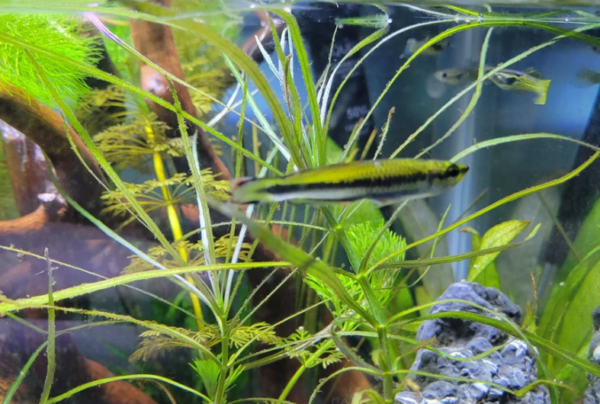
In the wild, more than 50 types of Madagascar rainbow fish can be found. Most of these species are similar in appearance, with a few minor elements differentiating them.
While nature doesn’t discriminate, a few are more popular among hobbyists for their coloration and calmer behavior in artificial waters.
- Bedotia geayi: Vibrant coloration of blue, green, and yellow. Commonly known as Geay’s rainbowfish.
- Bedotia marojejy: Commonly known as Marojejy rainbowfish, this species has a distinct coloration of black and white.
- Bedotia longianalis: Features a combination of blue, yellow, and black.
- Bedotia tricolor: Featuring red, black, and white, this species is commonly known as Tricolor rainbowfish.
Lifespan of Madagascar Rainbow Fish
On average, Madagascar rainbow fish have a lifespan of 3 to 5 years in captivity. However, with proper care, suitable environmental conditions, and genetic factors, some individuals may live longer, reaching up to 7 to 8 years.
In the wild, predators, diseases, and other external factors reduce their lifespan significantly.
A few factors that influence the lifespan of captive Madagascar rainbow are:
- Genetics: Some fish may inherit genetic diseases that contribute to a shorter lifespan, while others may live longer due to better genes.
- Water quality: The secret to keeping your Madagascar rainbow healthy for a long time is hidden in the water quality parameters. Consistently monitor the pH, hardness, ammonia, and other parameters to improve their lifespan.
- Diet and nutrition: Providing a proper diet to your rainbow fish will widen their lifespan.
- Tank size and environment: Offer your fish adequate tank space to swim around and hide.
- Breeding: Selective breeding of specific species may introduce genetic weaknesses, contradicting the longer lifespan of your fish.
Madagascar Rainbow Fish Size
Madagascar rainbow fish often reach a healthy 3-4 inches in captivity. While a few individuals may reach even up to 6 inches, that’s pretty rare. Female rainbows are slightly smaller than males.
Water parameters, diet, and tank size are rather influential factors in determining the adult size of your Madagascar rainbows.
To sustain their natural growth, introduce vitamins C, D, E, and B Complex to their diet. Most commercial pellets already provide those for you. Minerals, such as calcium, phosphorus, and trace minerals, are also essential for Madagascar rainbow fish.
Apart from the tank size, the tank dimensions also contribute to the overall growth of your fish. Being horizontal swimmers, your rainbows need more length than depth to swim freely. While decorations, especially live plants, are necessary, keep open swimming spaces available.
Madagascar Rainbow Fish Care & Tank Set-Up
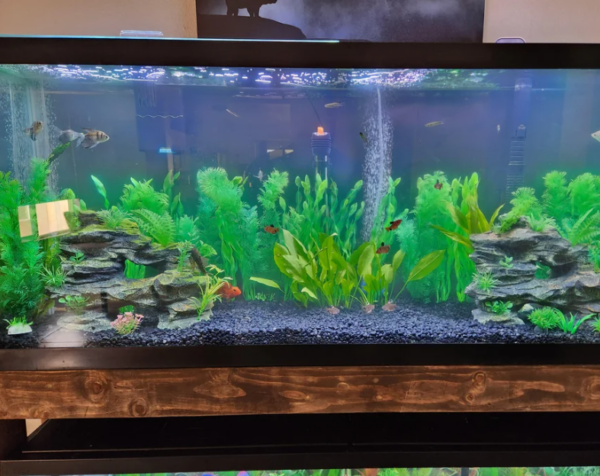
Tank parameters are pretty important to keep a healthy group of Madagascar rainbow fish. While they’re quite resilient and forgiving towards sudden parameter changes, these species aren’t capable of thriving in confined, unhealthy environments for long.
Tank Size and Specifications
Madagascar rainbow fish are genetically coded to love open waters. While you can’t provide exactly that, you can try not to limit their instincts through a smaller tank than necessary. They also have specific filtration and substrate requirements to live and grow.
Optimum Tank Size
For six juvenile Madagascar rainbows, a 30-gallon freshwater tank is ample enough. However, for adult rainbows, 100-110 gallons are required to sustain the same group. In the case of community tanks, the more space, the better.
As discussed, Madagascar rainbows are active swimmers and prefer horizontal tanks. Therefore, a minimum tank length of 3 feet is necessary to allow them to swim back and forth effortlessly.
The width and depth of the tank are less critical for rainbows. But, a width of at least 1.5 feet and a depth of 1 foot is advisable.
Overall, a 30-gallon tank dimension for rainbows would be 36 (L) X 12 (W) X 16 (H) inches. However, experiment with the dimensions according to your preference and limitations.
To calculate your own dimensions, use these conversions:
- To convert cubic inches to gallons, divide the volume by 231, as 1 gallon = 231 cubic inches (appx.)
- Volume in liters = volume in gallons * 3.7854 (appx.)
Filter Type
Madagascar rainbow fish produce a moderate bioload compared to other more active and bigger fish species. Regardless, providing an adequate filtration system is necessary to maintain mechanical and biological balance.
You may use two separate filters for mechanical and biological filtration, but we recommend using a single canister filter for the same. Make sure to choose a canister filter suitable for your tank size.
Canister filters generally allow you to fill the baskets with different kinds of filter media, such as:
- Mechanical media: Filter pads or floss are used to trap debris and organic particles in the filter. This helps in removing solid particles and helps prevent clogging of the filtration system.
- Biological media: Ceramic rings, bio-balls, and porous rocks provide more surface area for beneficial bacteria. These bacteria colonies break down the harmful ammonia and nitrite to maintain the biological balance of the aquarium.
- Chemical media (optional): Activated charcoal can be used to remove odors and impurities. However, they also nuke bacteria colonies to death. Chemical media aren’t necessary for Madagascar rainbow fish.
Substrate
As it replicates its natural habitat, fine-grain sand is particularly preferred for Madagascar rainbow tanks as a substrate choice. Soft and non-abrasive sand also allows them to be playful around the bottom, although they aren’t typically known to be interacting with the substrates.
Other substrate choices for rainbows may include:
- Fine gravel: Gravels of grain size around 1-3mm can be a good choice for Madagascar rainbow fish. They also allow easy cleaning and a more natural-looking bottom. Use smooth gravel to avoid injuring the fish.
- River rocks: Using natural substances like river rocks, pebbles, and a combination of different-sized stones can create a natural river bed environment for Madagascar rainbow fish.
- Plant substrate: If you have plants in your tank, consider using substrates designed to be beneficial for them.
How many Madagascar Rainbow Fish in 30 Gallon Tank?
6 small to medium-sized Madagascar rainbow fish can live in a 30-gallon tank.
Water Parameters for Madagascar Rainbow Fish
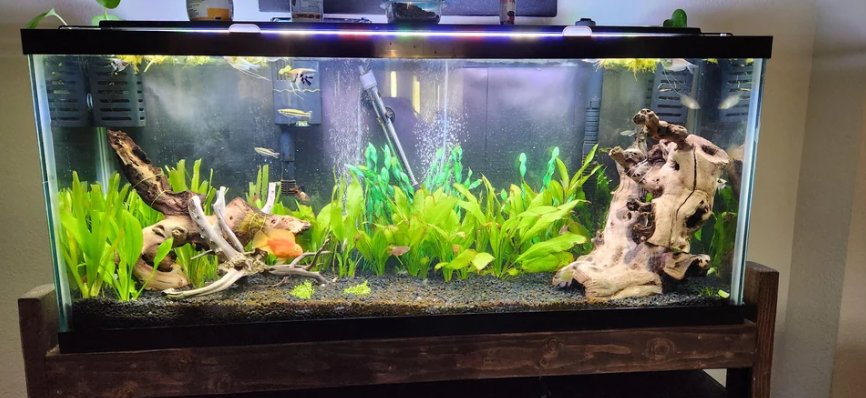
The Madagascar rainbow fish prefers a slightly acidic environment with a calm flow rate and low water hardness. Moreover, being freshwater fish, brackish water (slightly saline) isn’t optimum for their survival.
Tip: Change at least 50% water once every week, if not twice.
Water Temperature
The optimum water temperature to raise a healthy group of Madagascar rainbow fish is between 72 to 80 F (22 to 26 C). While they can resist a few degrees higher, colder temperatures impede doom on them. As they inhibit tropical climate rivers, they aren’t genetically designed to handle colder temperatures.
To keep your aquarium water warmer during winter, consider:
- Using an aquarium heater with an in-built thermostat to adjust the proximal temperature.
- Using your central heating system to gradually adjust the water temperature with the room temperature.
- Using heat pads below the aquarium to set a more linear temperature gradient.
- Reduce water flow and evaporation by adjusting filter heads and overhead pumps.
Water Flow Rate
owing to the monsoon in their natural habitat, Madagascar rainbow fish are capable of handling slightly stronger currents. But, they usually prefer calmer water. We recommend a water flow rate of 4 to 5 times the volume of your aquarium.
For example, if you’re keeping them in a 60-gallon aquarium, a flow rate of 240 to 300 GPH should be adequate. However, observe your school of fish in the initial stages to ensure that they aren’t struggling against the current. If so, adjust the flow rate or use fixtures like a flow control valve, prefilter, or spray bar.
However, we strongly advise against using a narrower inlet or output hose with the filter than recommended, as it puts extreme pressure on the pump.
pH Level
A slightly acidic pH of 6.5 to 7.5 is acceptable for Madagascar rainbow fish. While they can resist pH levels up to 8.5, it may put stress on their physiological processes. Behavioral changes, erratic swimming patterns, and osmoregulation issues are observed with pH imbalance.
To lower the pH levels in your aquarium:
- Use pH-adjusting products infused with mild acidic compounds. Be careful when using these products to adjust the pH levels and try to not go beyond the dosage recommended.
- Use natural acidic substances like driftwood, peat moss, and almond leaves. While it may affect water coloration, these are sustainable solutions to the pH problem.
- Use RO water mixed with your tap water to reduce pH levels. However, always test your tap water before using it, as they keep changing their source.
Water Hardness
8 to 25 dGH or 140 to 450 ppm of water hardness is suitable for Madagascar rainbow fish. Water hardness refers to the concentration of minerals and carbonates in the water. Maintaining an optimum water hardness level is critical for osmoregulation, ion exchange, and natural adaptations of your fish.
A slightly higher water hardness also works as a pH stabilizer for your aquarium.
You may decrease your tap water hardness by diluting it with soft water like RO or distilled water, using peat moss, and using ion exchange resins in your tank. Consider the impact of increased sodium in your fish before using resins.
In contrast, water hardness is increased by using crushed corals, using baking soda in moderation, and using mineral additives.
Madagascar Rainbow Fish Tank Landscape
You needn’t put much emphasis on the tank landscape for Madagascar rainbow fish except for a visual appeal. However, plants, on the other hand, are pretty critical for rainbows for feeding and breeding.
Best Plants for Madagascar Rainbow Fish Tanks
Waterscapes involving plants in Madagascar rainbow fish tanks are pretty beneficial for the species. Plants with bigger, softer leaves provide them with a natural hiding place, shade, and potential food sources. Moreover, they lay eggs on the leaves in their natural environment.
Suitable plants for Madagascar rainbow are:
- Anubias: Anubias plants are hardy and full of broad, dark green leaves where your rainbows can hide and lay eggs.
- Java Fern: Java Fern has textured, green leaves growing on both above and below the water surface.
- Amazon Sword: Best suited for larger aquariums, Amazon Sword has long, broad leaves to hide your precious rainbows.
- Vallisneria: Aka tape grass, Vallisneria has tape-like, long leaves to create a lush, natural appearance.
- Cryptocoryne: Planted in substrates, Cryptocoryne are slow growers that come in many varieties.
Worst Plants for Madagascar Rainbow Fish Tanks
Madagascar rainbow fish are pretty friendly towards their tank mates, both plants and other fish species. However, there are certain types of plants that shouldn’t be kept with them:
- Tough to maintain plants: Plants that are challenging to care for, like Glossostigma elatinoides or Hemianthus callitrichoides (HC), aren’t suitable for inexperienced keepers.
- Resource-hungry plants: High-demand CO2 and light-hungry plants, such as certain species of Rotala or Ludwigia, should be avoided.
- Fragile plants: The Rainbows can damage the plants through their active swimming habits.
- Floating plants: Floating plants, such as Duckweed or Water Lettuce, can reduce the light intensity of the tank—preventing the natural growth of your fish.
You should also avoid putting random plants in the tank to avoid contamination and chemical imbalance.
Decorations for Madagascar Rainbow Fish Tanks
Decorations suitable for Madagascar rainbow fish may include:
- Rocks and driftwood
- Live plants
- Artificial plants
- Caves and tunnels. Use PVC pipes and smooth clay pots.
Lighting for Madagascar Rainbow Fish Tanks
Adjusted to the day-night cycle, an intensity of 2 to 4 watts per gallon is adequate for rainbows and plants. Provide lighting for at least 8-10 hours a day for them to thrive and showcase their colors.
Feeding Madagascar Rainbow Fish
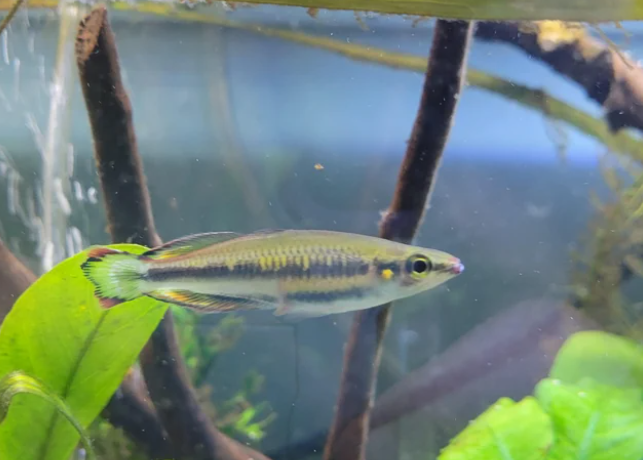
Omnivorous in nature, Madagascar rainbow fish accept pretty much anything as their potential food source. However, as a keeper, you must know what’s best for them.
Best Diet for Madagascar Rainbow Fish
High-quality pellets and flakes with occasional treats of small invertebrates and veggies are the best staples for Madagascar rainbow fish. Brine shrimp, daphnia, bloodworms, and blackworms can also be presented in both frozen or live forms.
How often should you feed Madagascar rainbow fish?
Whatever you may feed, considering their natural habits, feed them in small frequent portions. This helps prevent overfeeding and lethargy. Multiple times a day, optimally thrice, is appropriate for Madagascar rainbow fish.
Behavior and Temperament
Madagascar rainbows are social creatures and often exhibit schooling behavior, swimming together in unison and holding a pattern. You may reason with yourself to have more rainbows in your tank exclusively for this behavior.
They also are pretty acrobatic jumpers. While you may be amused to see such behavior, don’t forget to provide a secure cover. The Madagascar rainbow also loves flaring its fins and demonstrating the colors during courtship or territorial displays.
Being as mischievous as they are, you may often observe them nipping, chasing, and mock battling their friends. Don’t be alarmed by their behavior, as most of the time, it’s pretty harmless.
Tank Mates
If you’re considering keeping other fish species with your Madagascar rainbows, here is what you need to know.
Ideal Madagascar Rainbow Fish Tank Mates
The ideal tank mates for rainbows are calm, non-aggressive, and smaller in size. Here are a few fish species that are suitable for them:
- Boeseman’s Rainbowfish (Melanotaenia boesemani)
- Turquoise Rainbowfish (Melanotaenia lacustris)
- Neon Tetra (Paracheirodon innesi)
- Cardinal Tetra (Paracheirodon axelrodi)
- Rummy Nose Tetra (Hemigrammus rhodostomus)
- Harlequin Rasbora (Trigonostigma heteromorpha)
- Dwarf Gourami (Trichogaster lalius)
- Pearl Gourami (Trichogaster leeri)
- Honey Gourami (Trichogaster chuna)
- Corydoras Catfish (Corydoras spp.)
- Otocinclus Catfish (Otocinclus spp.)
- Kuhli Loach (Pangio kuhlii)
- Cherry Barb (Puntius titteya)
- Rosy Barb (Puntius conchonius)
- White Cloud Mountain Minnow (Tanichthys albonubes)
Bad Tank Mates for Madagascar Rainbow Fish
Typically, aggressive cichlids, large predatory fish, and fin-nipping fish are considered bad tank mates for Madagascar rainbow fish. Some common ones of them are:
- Oscars (Astronotus ocellatus)
- Arowanas (Osteoglossum spp.)
- Red Devils (Amphilophus labiatus)
- Flowerhorns (Hybrid cichlids)
- Jack Dempseys (Rocio octofasciata)
- Green Terrors (Andinoacara rivulatus)
- Tiger Oscars (Astronotus ocellatus)
- Jaguar Cichlids (Parachromis managuensis)
- Red Devils (Amphilophus labiatus)
- Pike Cichlids (Crenicichla spp.)
Breeding
Female Madagascar rainbow fish produce from a few dozen to a few hundred eggs during a breeding season.
To breed your favorite pair of Madagascar rainbow, follow these steps:
- Provide optimal water conditions (pH, temperature, hardness) and a nutritious diet to your rainbows. Feed them live food if possible during this time.
- Choose a breeding pair, similar in size and aggression. As they demonstrate dimorphism, it shouldn’t be hard to identify males and females. Transfer them to a breeding tank with spawning mops or plants.
- The male Madagascar usually initiates the breeding process by flaunting its colors and fins. The female complies with him by laying eggs in layers, while the male fertilizes them externally. The eggs will stick to the plants and the mops.
- The eggs usually hatch within a week. Ensure proper water parameters, temperature, and oxygen.
- Take care of the fry by feeding them crushed flakes, liquid food, or infusoria.
Common Diseases and Their Treatment
Common diseases of the Madagascar rainbow include:
- Ich (Ichthyophthirius multifiliis): identified by spots on the fish’s body and fins. Causes itching, flashing, and behavioral changes. You may raise the water temperature and use medication to remove the parasite.
- Fungal Infections: Symptoms include cotton-like growth on the fish’s body and around infections. Antifungal medications must be used to treat them.
- Bacterial Infections: Occurs as ulcers, fin rot, and open sores on the fish’s body. Using antibacterial medication and improving water condition is the best you can do.
Facts About Madagascar Rainbow Fish
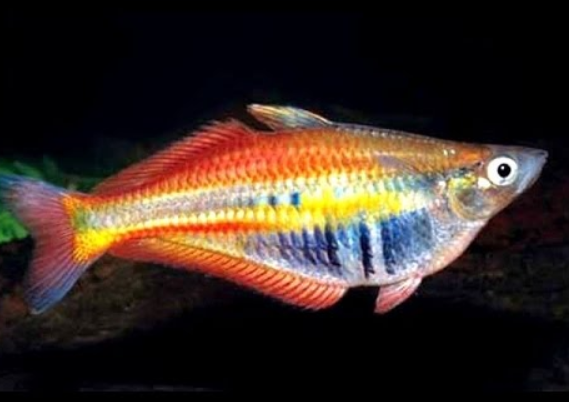
- Madagascar rainbow fish are peaceful and active swimmers. They add liveliness to aquariums and are best kept in schools of six or more individuals.
- Madagascar rainbow fish prefer slightly acidic to neutral water conditions and temperatures between 72-80 F (22-26°C).
- With an average size of 3 to 4 inches (7.6 to 10.2 cm), they make a captivating sight in aquariums.
- Being omnivores, they enjoy a varied diet of high-quality flakes, pellets, and live or frozen foods like brine shrimp and bloodworms.
- Male Madagascar rainbow fish exhibit vibrant colors and engaging courtship behaviors during breeding.
- Conservation efforts are crucial for some species of Madagascar rainbow fish, as they face habitat destruction and environmental threats in the wild.
Are Madagascar Rainbow Fish Right For You?
Being easy to maintain with a relatively broad parameter acceptance range, Madagascar rainbow fish are right for both beginners and experienced aquarium enthusiasts.
Check out our article on ‘Black Skirt Tetra‘.
The Bottom Line
We’ve tried to give as much tangential information as possible regarding Madagascar rainbow fish and their requirements. Hopefully, you’ll now be able to give proper care to your Madagascar rainbow fish without needing to experiment at the cost of their lives. All the best.
[ad_2]
Source link
